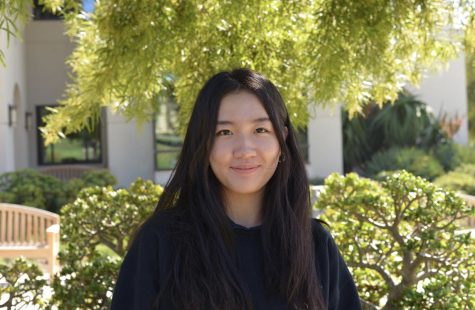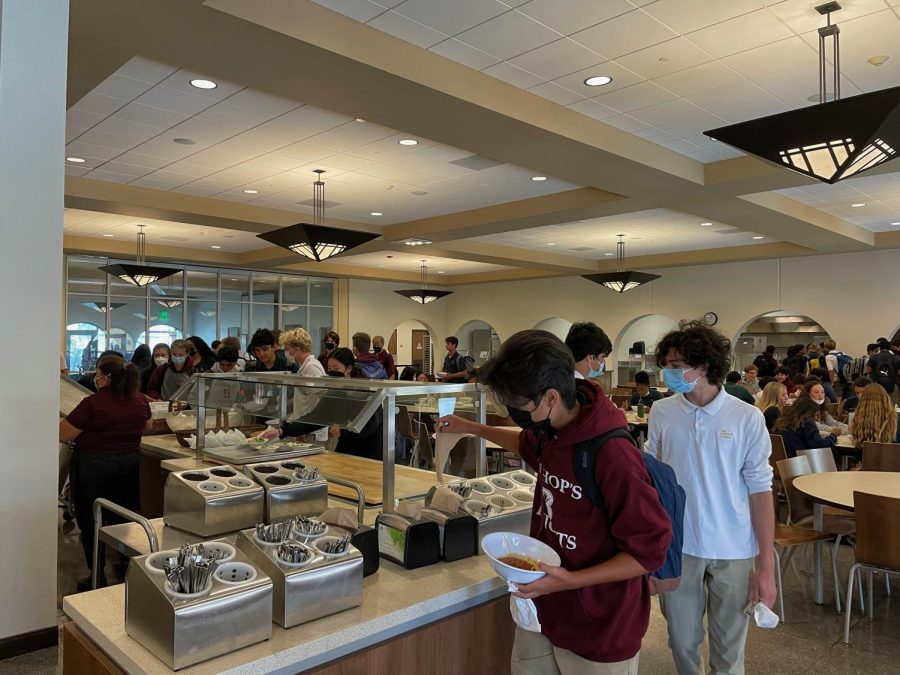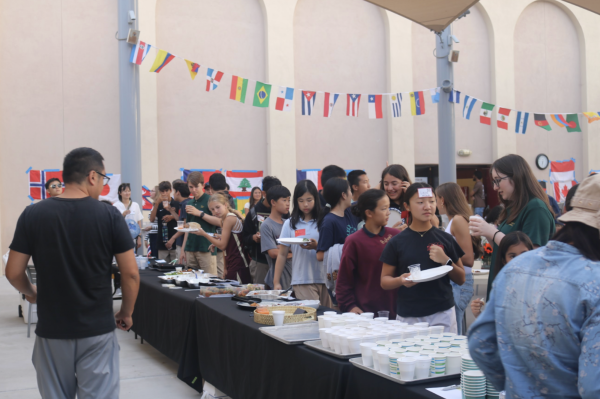Right Below Your Nose
Why we need to continue adhering to mask mandates as a community
It feels almost surreal. Being back on campus, mingling among your friends, lining up at the cafeteria… Although the fall of 2019 feels like a distant dream, what you’re seeing tugs at your excitement. Everything looks almost the same—except for those masks.
According to the California Department of Public Health, San Diego County currently recommends and requires masking in certain settings such as on public transit, campus indoors, and healthcare facilities. “Numerous studies have shown that masking actually protects people from getting the infection,” explained Dr. Anthony Pelletier, Science teacher and experienced virologist. “But it’s probably most effective at preventing people from giving the infection.”
Bishop’s has consistently made it clear that our community is committed to offering on-campus learning in a pandemic-conscious environment. “Students are much better at following the rules this year than last spring,” said Dr. Leo Landrey, a Latin teacher who strictly adheres to masking policies. “So I think we are doing better as a community.” Though the beginning of this school year has improved significantly from the uncertainty that dominated the last school year, we as a community should continue to hold ourselves up to the original standards—especially following pandemic guidelines such as mask mandates.
However, by just taking a quick walk around the indoor spaces on our campus, it is hard to ignore the countless masks carelessly hanging below students’ noses.
“Mask compliance has been spotty,” Dr. Pelletier observed. “The biggest problem I have seen is in casual settings… what has troubled me in places like lunch or chapel is people not wearing their masks properly and the adults around them not correcting them.”
As the highly contagious COVID-19 Delta variant sweeps across the country—and many people remain unvaccinated—some experts are advising people to go back to the basics of prevention. For many of us, that now means wearing a mask again even if we’ve had the vaccine. According to the Centers for Disease Control and Prevention (CDC), there has been a significant increase in new cases as of late August, contrasting what had been a steady decline since January of this year.
Towards the end of June, the seven-day moving average of reported cases was approximately 12,000; on July 27, however, the seven-day moving average of cases reached over 60,000. “I remember the days when the number of new cases in San Diego was very low,” Ms. Julianne Zedalis, a Biology and Forensic Science teacher known for her enthusiasm in maintaining classroom sanitation, recalled. “I think the Delta variant came out of the left field, and it took a lot of people by surprise.” This case rate resembled life before the vaccine was widely available.
This increase in cases is not exactly surprising as this new variant causes more infections and spreads faster than early forms of SARS-CoV-2, the virus that causes COVID. In two different studies from Canada and Scotland, patients infected with the Delta variant were more likely to be hospitalized than patients infected with Alpha or the original virus. Even so, the vast majority of hospitalization and death caused by COVID-19 are in unvaccinated people.
It’s clear that unvaccinated individuals remain the greatest concern. Fully vaccinated people get COVID-19 less often—referred to as breakthrough infections—than unvaccinated people. People infected with the Delta variant, including fully vaccinated people with symptomatic breakthrough infections, can transmit the virus to others. The CDC is continuing to assess data on whether fully vaccinated people with asymptomatic breakthrough infections can transmit the virus. Given what we know about the Delta variant, vaccine effectiveness, and current vaccine coverage, layered prevention strategies, including wearing masks, are needed to reduce the transmission of this variant.
“What we’re seeing now is extremely concerning,” said Dr. Edith Bracho-Sanchez, associate professor of pediatrics at Columbia University Irving Medical Center. A record-high 2,396 children were hospitalized with COVID-19 as of September 7, according to data from the US Department of Health and Human Services. And the school year has just started.
According to Bishop’s Knights News, of the school’s staff and faculty who have shared their vaccination status, more than 95% are fully vaccinated. Of the 74% of students who have shared their vaccination information, approximately 85% are fully vaccinated. It is important to note that the majority of the student body that are unvaccinated are in sixth grade—most are ineligible because vaccines still have not been approved for children under 12.
To be clear, there’s no evidence that the Delta variant is targeting children more than other age groups, but since the vaccines are still unavailable for youths in contrast to adolescents and adults, the cause is clear. Thinking closer to home,we have more than 150 sixth and seventh graders on our campus this year. With the Delta variant, the CDC recommends students from kindergarten through grade 12, along with teachers and visitors, to wear masks in school. In Mississippi and Florida, thousands of students just starting their school year have already had to quarantine. And it doesn’t take much for COVID-19 to shut down a school again. Even one case can have a ripple effect on students, faculty, and staff.
The science department is one group of faculty members who takes indoor classroom safety to another level. “My understanding is that you are supposed to wear a mask inside all the time in classes. The only exception is that you can take off your mask to drink… or to eat,” said Dr. Pelletier, who has a classroom in the basement of the science building. “But, for example, for my advisory, we don’t eat in here. When we have snacks, we go outside. It has proven very hard to catch this disease outside.”
Ms. Zedalis, who expressed that she feels extremely lucky to have a classroom filled with opened windows, also keeps strict watch over the adherence to mask mandates during school hours. All of her students appreciate the care she puts into placing sanitizers and sanitary wipes on each of the desks in the room for wiping commonly-used surfaces. Besides maintaining this COVID-friendly environment in her room, she also observes the entrance to the building, which is close to her workspace. “If I were to sit out there, I do see students going into the science building… without masks, arguing with me that only a [physical] classroom is really indoors,” she told me. “And I said no, since once you go through those doors, even if they’re open, you need your masks on.” Just as she finished her sentence, we observed a group of girls walking into the building unmasked.
“I think the policies we have are good,” said Juni Raisinghani (‘23), who has a sibling in 7th grade. “We just need people to take them more seriously, and in general, realize that this pandemic is far from over. We need to be more cautious.” James Hou (‘23), who also has a sibling in middle school, added, “I’d tell everyone to think less selfishly and think about how others can be affected by our own actions.”
So please, pull those masks above your nose.
Let’s make this a collective norm. Many faculties and students have used the word “community” repeatedly to emphasize what we need to do together as a school. “COVID-19 is a pretty scary disease, and mask-wearing is a simple thing we can do to keep each other safe and keep ourselves as a community learning in person healthy and strong,” Dr. Landrey remarked. It’s a little sacrifice to make to keep learning in-person safely and healthily.

Crystal Li joined The Tower in her freshman year when she moved from Shanghai to San Diego in 2019. Now a senior, she fondly looks back on the four-year...




![Leia (‘30) and Sara Park (‘32) ended their combative performance with a yell known as a kiyap. Leia explained with a proud smile, “I realized this when I was little, but not many people see taekwondo every day. For me, it’s a daily occurrence, so it feels very normal…when I do [a performance] in public, everyone’s like ‘Wow, that’s really cool’. So it always reminds me how this isn’t a normal thing in other people’s lives and I think it’s really cool that I can share that.”](https://thebishopstower.com/wp-content/uploads/2025/10/Screenshot-2025-10-02-at-2.07.47-PM-600x583.png)

